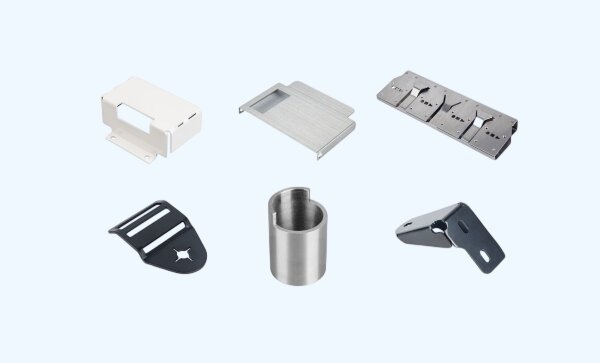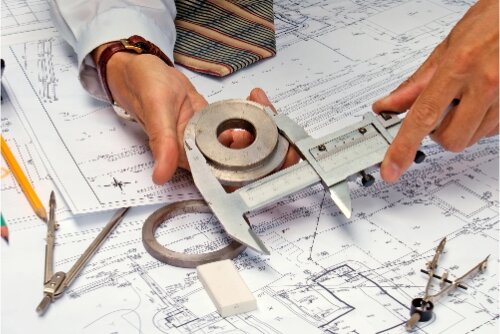모든 제품은 필요에 의해 시작됩니다. 하지만 그 아이디어를 실제 작동하는 제품으로 만드는 것이 항상 쉬운 일은 아닙니다. 많은 기업이 어려움에 직면합니다. 올바른 방법을 선택하거나 마감일을 맞추거나 비용을 관리하는 데 어려움을 겪을 수 있습니다. OEM 금속 가공은 이러한 문제를 해결하는 데 도움이 될 수 있습니다. 이 가이드에서는 시작 단계, 선택 사항, 유용한 팁을 통해 일반적인 실수를 피하고 시작하는 방법을 안내합니다.
OEM은 원활한 운영을 위해 정밀한 부품에 의존합니다. 좋은 제작 계획은 리드 타임을 단축하고 비용을 절감하며 제품의 신뢰성을 높일 수 있습니다. 제작업체와 협력할 때 고려해야 할 사항과 프로세스를 세분화해 보겠습니다.
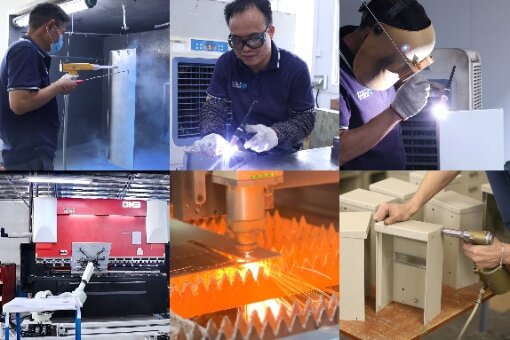
OEM 금속 제작이란 무엇인가요?
OEM 금속 제작은 기업의 설계에 따라 맞춤형 금속 부품 또는 어셈블리를 제작하는 프로세스입니다. 여기에는 절단, 굽힘, 용접 및 마감과 같은 단계가 포함됩니다. 이러한 부품은 OEM의 브랜드 이름을 가진 제품에 사용됩니다. 주요 목표는 디지털 파일을 품질과 성능 요구 사항을 충족하는 실제 작동하는 부품으로 바꾸는 것입니다.
OEM은 주문자 상표 부착 생산업체의 약자입니다. 이 설정에서는 OEM이 도면이나 사양을 제공합니다. 제작업체는 기계와 숙련된 작업자를 사용하여 실제 부품을 제작합니다. 이 프로세스는 기성 부품을 사용하는 것과는 다릅니다. 모든 부품은 특정 작업이나 제품을 위해 만들어지기 때문에 정밀도와 반복성이 매우 중요합니다.
OEM 금속 제조 서비스의 유형
OEM 금속 제조에는 미가공 금속 또는 평판을 완제품으로 만드는 여러 공정이 포함됩니다. 각 단계마다 중요한 역할을 하며, 올바른 공정을 선택하는 것이 비용, 품질 및 리드 타임에 영향을 미칩니다.
판금 절단 및 펀칭
절단은 재료를 제거하여 금속의 모양을 만듭니다. 깔끔한 모서리와 정확한 크기를 만듭니다. 표준 절단 방법은 다음과 같습니다. 레이저 절단, 플라즈마 절단, 그리고 워터젯 절단. 열 또는 고압을 사용하여 금속을 빠르고 정확하게 절단합니다.
펀칭 는 다른 접근 방식입니다. 펀치와 다이를 사용하여 시트에서 모양을 누릅니다. 빠르고 반복 가능하며 구멍, 슬롯 또는 컷아웃을 만드는 데 이상적입니다. 또한 다른 방법보다 낭비가 적습니다.
절단과 펀칭은 종종 제작 작업의 첫 번째 단계입니다. 벤딩, 용접 또는 조립 전에 평평한 시트를 준비합니다.
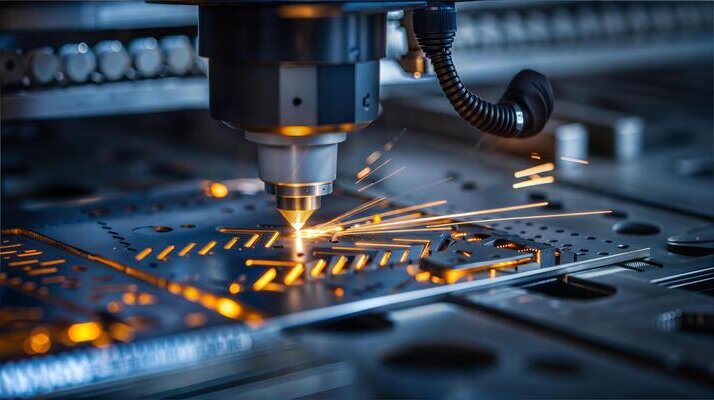
벤딩 및 성형 프로세스
벤딩 금속을 자르지 않고 모양을 변경합니다. 프레스 브레이크는 자주 사용하는 도구입니다. 프레스 브레이크는 시트를 다이에 밀어 넣어 직각으로 구부립니다. 이음새나 접합부가 없기 때문에 금속이 튼튼하게 유지됩니다.
형성 굽힘을 포함하지만 스탬핑, 압연 및 딥 드로잉도 포함됩니다. 이러한 방법은 더 넓은 영역에 힘을 가해 금속을 성형합니다. 곡선, 모서리 또는 깊은 모양을 만드는 데 적합합니다.
정확한 벤딩과 성형은 좋은 도구, 기계 설정 및 재료에 따라 달라집니다. 올바르게 사용하면 재작업이 줄어들고 빌드 프로세스의 속도가 빨라집니다.
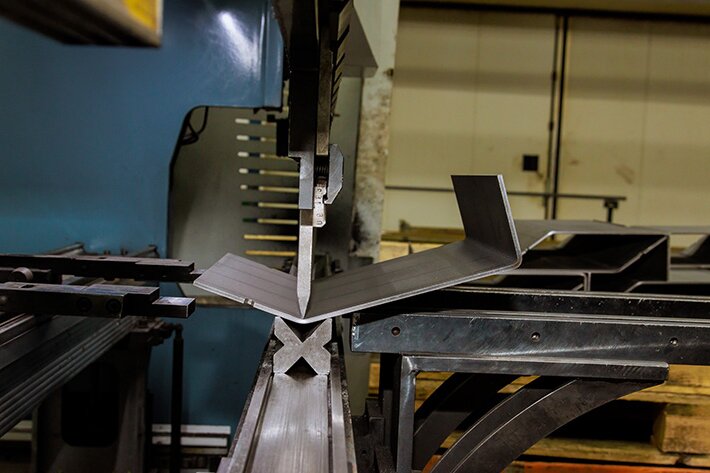
용접 및 접합 기술
용접 금속 부품을 하나의 단단한 조각으로 결합합니다. 응력을 잘 견디는 강력한 연결을 만듭니다. 일반적인 용접 유형에는 MIG, TIG, 스폿 용접이 있습니다. 용접 방법은 금속 종류, 두께, 최종 용도에 따라 다릅니다.
미그 용접 는 빠르고 두꺼운 부품에 잘 작동합니다. TIG 용접 는 더 깨끗하고 섬세한 결과물을 제공하며 얇은 소재에 더 적합합니다. 스폿 용접 압력과 열을 사용하여 설정된 지점에서 부품을 결합하는 것으로 판금에 주로 사용됩니다.
다음과 같은 다른 가입 방법 리벳팅 열이 이상적이지 않거나 나중에 부품을 분리해야 하는 경우 볼트로 작업합니다. 적절한 방법을 선택하면 최종 제품이 튼튼하고 오래 사용할 수 있습니다.
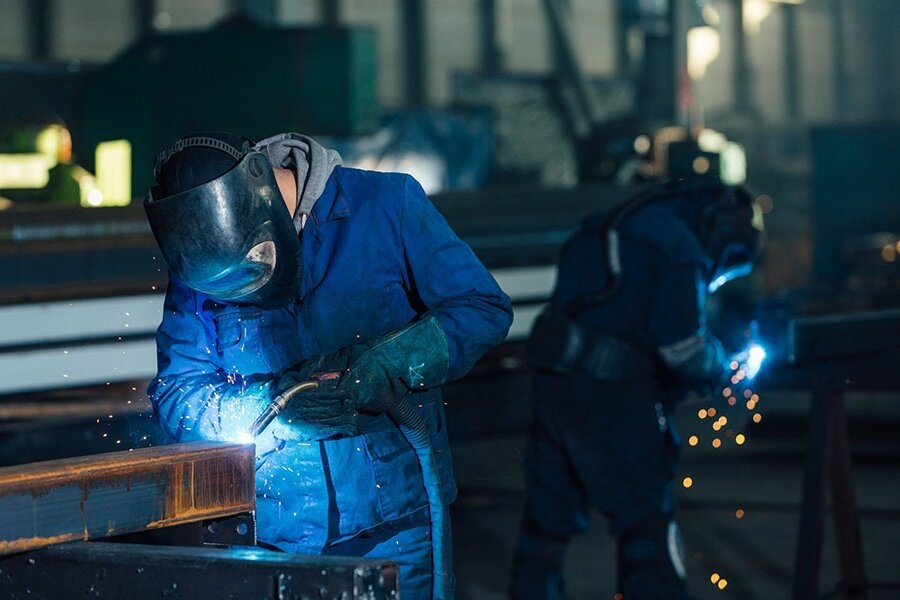
정밀 부품을 위한 CNC 가공
CNC 가공 금속을 매우 정확하게 성형합니다. 구멍, 나사산 또는 엄격한 공차 기능을 추가하는 데 자주 사용됩니다. CNC 밀과 선반은 디지털 지침에 따라 부품을 사양에 맞게 정밀하게 절단합니다.
이 방법은 프로토타입과 전체 생산 모두에 적합합니다. 알루미늄, 황동, 강철 등 다양한 금속에 사용할 수 있습니다. CNC 가공은 종종 절단 또는 성형 후 최종 디테일을 추가하기 위해 사용됩니다.
높은 정밀도, 우수한 표면 품질 및 반복성을 제공합니다. CNC는 부품이 완벽하게 맞아야 하거나 사용 중에 부드럽게 움직여야 할 때 현명한 선택입니다.
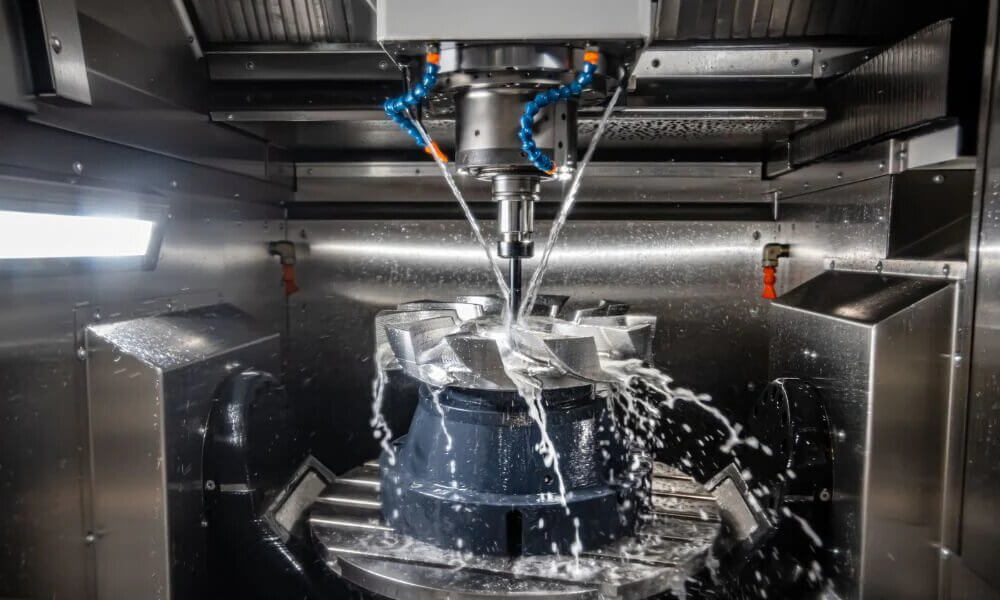
표면 처리 및 마감 옵션
표면 마감 부품의 외관, 성능 및 내구성을 개선합니다. 녹을 방지하고, 색상을 추가하거나, 내마모성을 향상시킬 수 있습니다. 표준 마감에는 분말 코팅, 아노다이징, 도금 및 연마가 포함됩니다.
분체 도장 는 긁힘에 강한 견고하고 화려한 마감을 더합니다. 아노다이징 은 주로 알루미늄에 사용되며, 단단하고 부식에 강한 표면을 만듭니다. 도금 아연이나 니켈과 같은 얇은 금속 층을 추가하여 외관과 내구성을 높입니다.
다음과 같은 기타 옵션 브러싱, 비드 블라스팅, 또는 세련 표면 느낌을 변경할 수 있습니다. 매끄럽게 광택을 내거나 무광택으로 보이게 할 수 있습니다. 마감은 부품을 포장하여 배송하기 전 마지막 단계입니다. 제품을 보호하고 깨끗하고 완성된 외관을 제공합니다.
OEM 제작에 일반적으로 사용되는 재료
소재 선택은 부품의 성능에 중요한 역할을 합니다. 각 금속은 강도, 비용, 내식성, 가공 용이성에서 장단점이 있습니다. 다음은 올바른 소재를 선택하는 데 도움이 되는 간단한 비교표입니다:
| 소재 | 인장 강도(MPa) | 항복 강도(MPa) | 부식 저항 | 밀도(g/cm³) | 가공성 | 재활용성 | 비용 |
|---|---|---|---|---|---|---|---|
| 알류미늄 | 70-700 | 35-280 | 좋은 | 2.7 | 훌륭한 | 훌륭한 | 낮음에서 중간 |
| 스테인레스 스틸 | 480-1400 | 170-1500 | 훌륭한 | 7.9 | 공정한 | 훌륭한 | 중간에서 높음 |
| 온화한 강철 | 370-700 | 200-400 | 열악함에서 공정함 | 7.85 | 좋은 | 좋은 | 낮은 |
| 구리 | 210-370 | 33-250 | 훌륭한 | 8.96 | 좋은 | 훌륭한 | 중간에서 높음 |
| 티탄 | 480-1400 | 275-1200 | 훌륭한 | 4.5 | 가난한 | 훌륭한 | 높은 |
전문 OEM 금속 제작업체와 협력할 때의 이점
숙련된 OEM 금속 가공업체와 협력하면 완성된 부품 그 이상을 얻을 수 있습니다. 프로젝트에 속도, 기술 지원, 유연성을 더할 수 있습니다. 올바른 파트너를 통해 작업을 더 쉽게 만드는 방법은 다음과 같습니다.
리드 타임 단축 및 안정적인 배송
숙련된 제작자는 시간, 재료, 기계를 관리하는 방법을 잘 알고 있습니다. 이들은 일을 계속 진행하고 필요할 때 부품을 준비할 수 있도록 합니다.
리드 타임이 빠르면 마감일을 맞추고 지연을 방지하며 경쟁에서 앞서나갈 수 있습니다. 또한 오랜 시간 멈추지 않고 생산 라인을 계속 가동할 수 있습니다.
전문가 엔지니어링 및 설계 지원
좋은 제작업체는 도면을 따르는 것 이상의 일을 합니다. 엔지니어는 디자인을 개선할 방법을 찾습니다. 더 나은 재료, 더 엄격한 허용 오차 또는 생산하기 쉬운 더 간단한 기능을 제안할 수 있습니다.
이러한 종류의 입력은 향후 문제를 방지하는 데 도움이 됩니다. 또한 비용을 절감하고 부품의 성능을 보장할 수 있습니다.
한 명에서 수천 명까지 확장 가능한 생산성
신뢰할 수 있는 제작업체는 하나의 프로토타입이 필요하든 수천 개의 완제품이 필요하든 모두 처리할 수 있습니다. 소규모로 시작하여 디자인을 테스트한 다음 필요성이 커지면 주문량을 늘릴 수 있습니다.
이렇게 하면 시간과 노력이 절약됩니다. 확장할 준비가 되었을 때 새로운 공급업체를 찾거나 프로세스를 변경할 필요가 없습니다.
맞춤형 부품 및 마감재를 위한 유연성
OEM 프로젝트에는 맞춤형 모양, 특수 기능 또는 독특한 마감 처리가 필요한 경우가 많습니다. 전문 공방에서는 이러한 요구 사항을 속도 저하 없이 처리할 수 있습니다. 이들은 CNC 기계, 레이저 커터, 프레스 브레이크와 같은 고급 도구를 사용하여 고객의 사양에 맞는 부품을 제작합니다.
원하는 크기, 모양, 기능을 타협 없이 구현할 수 있습니다. 맞춤형 작업은 더 이상 어려운 일이 아니라 서비스의 표준이 되었습니다.
OEM 금속 제조에 의존하는 산업 분야
OEM 금속 제조는 강력하고 정밀하며 신뢰할 수 있는 부품을 필요로 하는 많은 산업을 지원합니다. 이러한 부품은 안전, 기능 및 제품 수명에 중요한 역할을 하는 경우가 많습니다.
자동차 및 전기차 부품
자동차, 트럭 및 전기 자동차는 강도와 안전을 위해 금속 부품에 의존하며, 가공 부품에는 다음이 포함됩니다. 괄호, 인클로저, 배터리 트레이 및 섀시 부품. 엄격한 크기 및 강도 규칙을 충족해야 합니다.
제작은 또한 전기차의 경량 설계를 지원합니다. 알루미늄과 고강도 강철은 내구성을 유지하면서 차량 무게를 줄이는 데 도움이 됩니다.
항공우주 및 항공 부품
비행기와 드론에는 가볍고 튼튼한 부품이 필요합니다. 금속 가공은 압력과 진동을 견디는 구조 프레임, 브래킷 및 패널을 제작하는 데 도움이 됩니다.
엄격한 공차와 인증된 재료가 필요하며, 제작업체는 엄격한 항공우주 표준을 따라야 합니다. 따라서 모든 단계에서 정밀도와 품질 관리가 매우 중요합니다.
의료 기기 및 장비
병원에는 깨끗하고 안전하며 튼튼한 금속 부품이 필요합니다. 녹에 강하고 반복적인 세척이 가능한 스테인리스 스틸이 표준으로 사용됩니다. 수술 도구, 프레임, 카트 및 하우징에는 제작이 사용됩니다.
제작업체는 클린룸 또는 FDA 관련 표준을 충족해야 합니다. 일관성과 표면 마감이 핵심인 경우가 많습니다.
가전
휴대폰, 노트북, 가정용 기기는 강도와 외관을 위해 금속 부품을 사용합니다. 얇은 알루미늄 쉘과 브래킷은 좁은 공간에 맞게 절단, 구부려서 마감합니다.
제작을 통해 맞춤형 모양과 깔끔한 마감으로 대량 생산이 가능합니다. 또한 EMI 차폐 및 열 제어를 지원합니다.
산업용 기계 및 장비
농업, 포장 또는 생산 기계는 무거운 하중과 마모를 견디는 금속 부품을 사용합니다. 브래킷, 커버, 지지대, 하우징은 절단, 용접, 성형으로 제작되는 경우가 많습니다.
OEM 제작은 소량 생산과 대량 주문을 모두 지원합니다. 제조업체는 기계 설계 및 사용 사례에 맞는 내구성 있는 부품을 얻을 수 있습니다.
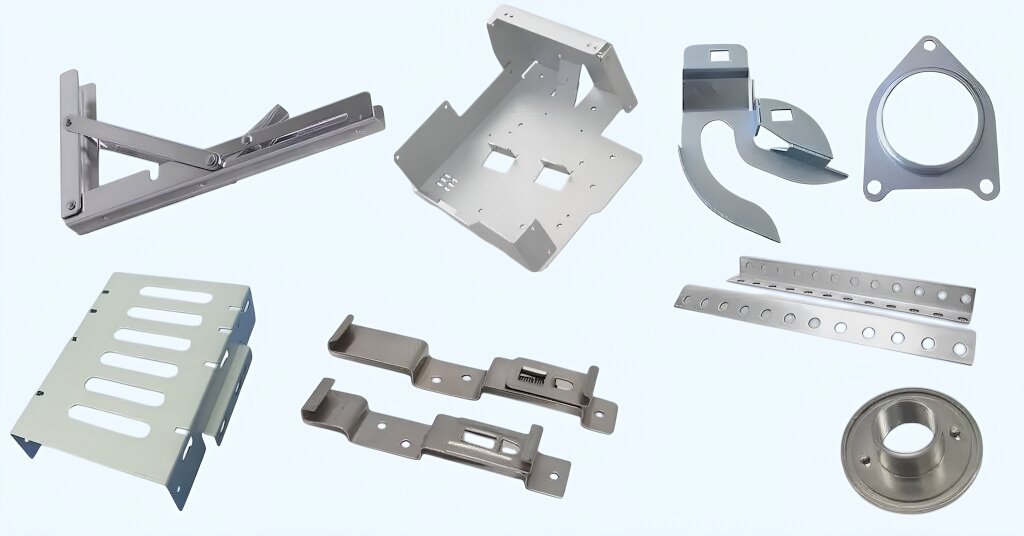
OEM 제작과 계약 제조
OEM 제작과 계약 제조는 모두 부품 또는 제품 생산을 지원하지만 접근 방식이 다릅니다. 이 두 가지가 어떻게 다른지 이해하면 프로젝트에 적합한 방식을 선택하는 데 도움이 될 수 있습니다.
비즈니스 모델의 핵심 차이점
OEM 제작에서는 고객이 디자인을 소유합니다. 제작업체는 고객의 도면과 사양을 기반으로 부품을 제작하며, 일반적으로 제품에 맞게 맞춤 제작합니다. 이 모델을 사용하면 디자인, 품질 및 브랜드를 제어할 수 있습니다.
계약 제조는 더 광범위합니다. 여기에는 완전한 제품 조립, 자재 소싱, 때로는 제품 디자인까지 포함되는 경우가 많습니다. 때로는 고객이 아닌 계약업체가 디자인을 제공하고 처음부터 끝까지 제품을 제작하기도 합니다.
OEM 제조는 맞춤형 부품을 만드는 것입니다. 계약 제조는 완전한 제품을 제공하는 것입니다.
계약 작업보다 OEM 제작을 선택해야 하는 경우
이미 디자인이 있고 부품을 제작할 숙련된 파트너가 필요한 경우 OEM 제작을 선택하세요. 재료, 치수, 품질에 대한 완벽한 제어를 원하는 경우 적합한 선택입니다.
특히 디자인, 조립 및 포장에 대한 도움이 필요한 경우 완전한 제품이 필요한 경우 계약 제조를 선택하세요. 이는 전자 제품, 소비재 또는 의료 기기와 같은 산업에서 흔히 볼 수 있습니다.
정확한 요구 사항을 충족하는 맞춤형 부품에 집중하는 경우 OEM 제작을 통해 더 많은 제어와 유연성을 확보할 수 있습니다.
제품 개발 주기와 통합
OEM 제작자는 종종 디자인 프로세스 초기에 참여합니다. 이들은 재료, 공차 및 제조 가능성에 대한 피드백을 제공할 수 있습니다. 이러한 지원을 통해 개발 속도를 높이고 나중에 변경해야 할 필요성을 줄일 수 있습니다.
계약 제조업체는 일반적으로 디자인이 완성된 후에 참여합니다. 이는 성숙한 제품에는 적합할 수 있지만 초기 단계의 프로토타입에는 적합하지 않을 수 있습니다.
여러 단계를 거쳐 디자인을 다듬고 테스트하는 데 도움이 필요하다면 OEM 제작이 더 좋습니다.
올바른 OEM 금속 제조 파트너를 선택하는 방법은?
올바른 제작 파트너를 선택하면 시간을 절약하고 비용을 절감하며 부품 품질을 개선할 수 있습니다. 하지만 잘못된 파트너를 선택하면 지연, 품질 문제, 기회 손실로 이어질 수 있습니다. 결정할 때 고려해야 할 사항은 다음과 같습니다.
살펴봐야 할 주요 특성
특히 업계에서 쌓은 경험부터 시작하세요. 부품 유형을 잘 이해하는 제작업체는 문제를 조기에 발견하고 보다 혁신적인 솔루션을 제공할 수 있습니다.
역량을 확인하세요. 절단, 절곡, 용접 및 마감을 자체적으로 처리하나요? 한 지붕 아래에서 더 많은 서비스를 제공할수록 프로세스가 더 원활하고 빨라집니다.
커뮤니케이션도 중요합니다. 빠른 답변, 명확한 업데이트, 정시 배송에 대한 강력한 기록이 있는지 확인하세요. ISO 9001과 같은 인증은 품질을 중요하게 여기고 일관된 프로세스를 따르고 있음을 보여줍니다.
평가 시 질문할 사항
- 어떤 재료와 두께를 취급할 수 있나요?
- 내 공차 및 표면 마감 요구 사항을 충족할 수 있나요?
- 프로토타입과 프로덕션 실행에 걸리는 일반적인 리드 타임은 어떻게 되나요?
- 품질을 관리하고 부품 정확도를 확인하는 방법은 무엇인가요?
- 이전에 비슷한 부품이나 업계에서 일한 적이 있나요?
이러한 질문을 통해 해당 기능을 더 잘 이해하고 나중에 놀랄 일을 방지할 수 있습니다.
기능 확인 및 실제 사례
사례 연구, 사진 또는 샘플 부품을 요청하세요. 크기, 형태 또는 기술적 요구 사항이 비슷한 프로젝트를 찾아보세요.
가능하다면 매장을 방문해 보세요. 자재, 기계, 워크플로우를 어떻게 관리하는지 자세히 살펴볼 수 있습니다. 그들의 작업이 약속한 품질과 일치하는지 확인할 수 있습니다.
실제 사례와 잘 운영되는 운영 사례는 단순한 세일즈 피치 이상의 것을 말해줍니다. 제작자가 진정으로 고객의 목표를 달성할 수 있음을 보여줍니다.
결론
OEM 금속 제작은 디자인을 실제 작동하는 정품 부품으로 바꿔줍니다. 여기에는 절단, 굽힘, 용접 및 마감이 포함됩니다. 올바른 제작업체를 선택하면 정확한 부품, 짧은 리드 타임, 프로토타입부터 대량 생산까지 완벽한 지원을 받을 수 있습니다. OEM 금속 제조는 자동차부터 의료 및 전자제품에 이르기까지 다양한 산업에 적합합니다.
맞춤형 금속 부품에 대한 도움이 필요하신가요? 빠른 견적을 원하시면 팀에 문의하세요전문가의 조언과 고객의 요구에 맞춘 신뢰할 수 있는 OEM 제작 솔루션을 제공합니다.
자주 묻는 질문
OEM과 ODM의 차이점은 무엇인가요?
OEM(주문자 상표 부착 생산)은 디자인을 제공하면 제작업체가 고객의 사양에 따라 부품을 제작하는 방식입니다. 디자인을 소유하는 것입니다.
ODM(주문자 상표 부착 생산)은 공급업체가 디자인을 제공하고, 귀사가 완제품을 구매하여 귀사의 브랜드로 판매하는 것을 의미합니다.
OEM 금속 제작업체가 설계 및 프로토타입 제작에 도움을 줄 수 있나요?
예. 많은 OEM 제작업체가 초기 단계에서 지원을 제공합니다. 디자인을 검토하고, 더 나은 재료를 제안하고, 프로토타입을 제작할 수 있습니다. 이를 통해 문제를 조기에 발견하고 더 나은 생산 결과를 얻을 수 있습니다.
OEM 판금 부품을 제작하는 데 시간이 얼마나 걸리나요?
리드 타임은 부품에 따라 다릅니다. 간단한 부품은 5~10일이 소요될 수 있습니다. 특히 맞춤형 툴링이나 표면 마감이 있는 더 복잡한 부품은 2~4주가 소요될 수 있습니다. 제작업체에 직접 일정을 확인하는 것이 가장 좋습니다.
OEM 제작을 아웃소싱할 때 품질이 좋은지 어떻게 확인할 수 있나요?
ISO 인증 및 자체 품질 검사를 받은 제작업체와 협력하세요. 검사 보고서, 테스트 단계, 결함 처리 방식에 대해 문의하세요. 또한 실수를 방지하기 위해 도면과 사양이 정확한지 확인하세요.
소량 주문의 경우 OEM 제작이 비용 효율적입니까?
네. OEM 상점에서는 소량 생산에 적합한 레이저 절단 및 CNC 가공과 같은 유연한 방법을 사용하는 경우가 많습니다. 높은 툴링 비용을 피하고 더 빠르게 생산할 수 있어 맞춤형 또는 소량 생산에 이상적입니다.
안녕하세요, 저는 케빈 리입니다

지난 10년 동안 저는 다양한 형태의 판금 제작에 몰두해 왔으며 다양한 워크숍에서 얻은 경험에서 얻은 멋진 통찰력을 이곳에서 공유했습니다.
연락하세요

케빈 리
저는 레이저 절단, 굽힘, 용접 및 표면 처리 기술을 전문으로 하는 판금 제조 분야에서 10년 이상의 전문 경험을 갖고 있습니다. Shengen의 기술 이사로서 저는 복잡한 제조 문제를 해결하고 각 프로젝트에서 혁신과 품질을 주도하는 데 최선을 다하고 있습니다.



